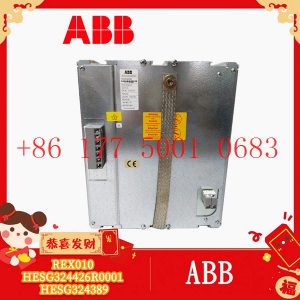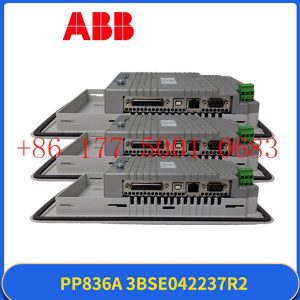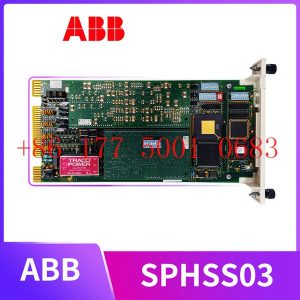Description
hardware flow control. It is an ideal choice in the field of industrial automation.
Implementation of communication between ABC industrial robot and PLC based on DeviceNet fieldbus technology
introduction
In modern production systems, industrial robots and PLCs need to communicate and collaborate to complete production tasks. That is, the
industrial robots output signals to the PLC, allowing the PLC to control related equipment to drive the robot”s front-end tools. This article
mainly analyzes the communication problems between ABB industrial robots and PLC based on DeviceNet fieldbus technology.
DeviceNet is a common network communication method in the field of automation. ABB industrial robots establish a network to communicate with
Siemens PLC based on the DeviceNet network.
1Configure DSQC652
There are mainly 5 types of standard I/0 boards commonly used in ABB industrial robots [2]. Except for the different addresses assigned to
them during setup, their configuration methods are basically the same. This article mainly analyzes the ABB standard I/0 board DS0C652, which
mainly builds communication modules based on the DeviceNet network. The DS0C652 board has a distributed I/O module with 16 digital input and 16
digital output interfaces. The board is installed in the ABB industrial robot control cabinet. First, define the specific operation steps of the DS0C652 board,
enter the teach pendant control panel, then enter the configuration menu (Figure 1), select the DeviceNetDevice menu, and add a template to enter Figure 2.
ABB standard I/0 board is hung on the DeviceNet
network, so the address of the module in the network must be set. The jumpers 6 to 12 of terminal x5 are used to determine the address of the module.
The available address range is 10 to 63. Modify the parameters in the template parameters to complete the DS0C652 board settings. Click the drop-down
menu to select the “Use value from template” row, select
“DS0C65224VDCI/0Device”, and then the parameters that need to be set include the address of the I/0 board in the bus.
Figure 1 Configuring DSQC652
2Configure signals and parameters
After completing the DS0C652 board setting, the I/0 signal setting will be performed. Setting the I/0 signal is the basis for establishing communication with
the PLC. The PLC communicates and transmits data with the ABB industrial robot through the I/0 signal and the DS0C652 board. As shown in Figure 3, in the
signal configuration interface, there are many default I/0 points after the system is established. Modification is not allowed. Click “Add” to add signals. When setting
input and output signals, their address range is 0~15. First, enter the signal menu in the configuration options to set the input and output types, and modify the corresponding parameters.
After completing the settings, the computer prompts that you need to restart the settings. If there are multiple signals that need to be defined and the waiting time
is long after restarting multiple times, you can click “Cancel” and wait for all signals to be defined before clicking the “Yes” button to restart. After the signal settings are
completed, click to select “Input and Output” in the ABB menu to check whether all signals have been set.
Figure 2 Configure DSQC652 parameters
Figure 3 Signal parameter settings
During the signal establishment process, attention should be paid to the DSoC652 port and PLC port addresses used, and the corresponding address table should be
established, as shown in Table 1. The robot interacts with the PLC through I/O signals. During the setting process, there must be no errors in the port and address number
of the PLC connected to the DSoC652. If the address is set incorrectly, the communication between the robot and the PLC will not work properly.
The entire robot teaching pendant setting process is shown in Figure 4.
https://www.xmamazon.com
https://www.xmamazon.com
https://www.plcdcs.com/
www.module-plc.com/
https://www.ymgk.com
BAB-740 11887 REV F PMCE-740 REV B.202012230809379 ELTEC
SST-DN3-PCI-2 DSQC658 SST ingle channel robot graphics card
UFC760BE43 3BHE004573R0043 ABB DCS / PLC system module
SK829007-B ABB RC surge suppressor
UR8AH GE Universal Relay UR Series
FBM232 P0926GW Foxboro Ethernet Communication Module
6ES7972-0BA60-0XA0 SIEMENS DP bus connector
VMIVME-5565 GE Ultra-high-speed optical fiber reflective memory
KUC755AE106 3BHB005243R0106 ABB Portal crane power exciter control module
UR6UH GE Digital input / output module universal relay ur series
E33NCHA-LNN-NS-00 Pacific Scientific Hybrid Step Motor in the E Series
JANCD-XCP0101C-1 YASKAWA Controller Board
CPS-150F YASKAWA Power Supply
PP825 3BSE042240R1 ABB Panel 800 Operator Panel
3500/42M 176449-02 Bently Nevada Proximitor/Seismic Monitor
DECS-200-2L BASLER ELECTRIC Digital Excitation Control System
OCAHG492838402 ABB PLC circuit board
SC-UCMX01 51307195-175 HONEYWELL RTU2020 CONTROLLER
OCAHG 492838402 ABB Analog output 4ch
OCAH 940181103 ABB Output panel
1746-NO4VA A-B SLC 500 Analog Output Module
NDCU-12C NDCU-12CK ABB DRIVE CONTROL UNIT
CB06551 PRD-B040SSIB-63 KOLLMORGEN SERVO DRIVE
FC-PSU-UNI2450U V1 Honeywell Power Supply Module
MOX12-P3509 B 80026-173-23 ABSOLUTE POWER SUPPLY
TP854 3BSE025349R1 ABB Baseplate
XV-440-10TVB-1-20 EATON ELECTRIC Terminal Tactil 10.4″
VMIVME-7455 GE Standard VME double height Eurocard
UR6DH GE Digital I/O Input Output UR Series Universal Relay Module
VMIVME-4140 GE 16-Channel 12-bit Analog Output Board
VMIVME-2128 GE Digital Output Board
DSSR122 4899001-NK ABB Power Supply Unit
3BSE008538R1 ABB Terminator for Modulebus
3401 TRICONEX Digital Output Module
2000417 TRICONEX Safety Manager Module
2000418 TRICONEX Safety Manager Module
3381 TRICONEX Safety Manager Module
3301 TRICONEX Digital Input Module Each TMR Digital Input Module
3351 TRICONEX Analog Input Module
3201 TRICONEX Communication Module









Reviews
There are no reviews yet.